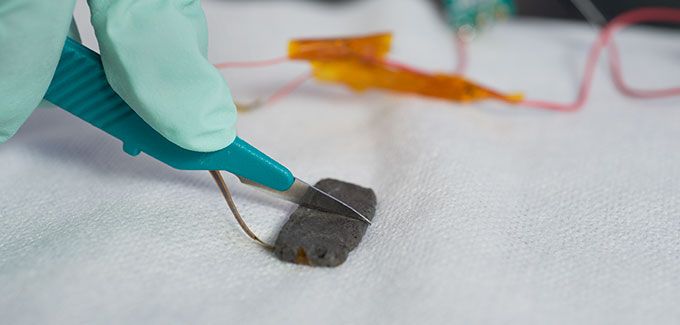Self-Healing 'Skin' Has a Sense of Touch

A new, flexible material is able to sense touch and heal itself from cuts. Sound familiar? Human skin can feel pressure, flexing and other textures, of course, and it's able to fix small cuts. This new, man-made material is designed to reproduce some of the basic abilities of human skin, so that prosthetic limbs and robots in the future can have an artificial skin covering.
Over the past decade, several research groups have tried to make artificial skin for robots and other electronic devices. This is the first that is able to not only seal itself back up after it's been sliced in two, but also regain its ability to sense touch after getting snipped.
"I think it's kind of a breakthrough," John Boland, a Trinity College Dublin chemist, told Science magazine. "It's the first time that we've seen this combination of both mechanical and electrical self-healing." Boland was not involved in making the new skin.
The new material is made with a polymer, a plastic-like material, that has atoms of nickel embedded inside. The polymer gives the skin its self-healing ability, because the polymer's molecules are able to connect to one another again after the polymer is cut. It's also slightly flexible — a bit stiffer than saltwater taffy.
Meanwhile, the nickel atoms infuse the skin with a sense of touch because they are able to conduct electricity. When someone presses or twists the skin, it changes the distance between the nickel atoms and alters the electricity flow between the atoms. In the future, a computer program could interpret that altered electrical flow as touches. The new skin is sensitive enough to detect the pressure of a handshake, Benjamin Tee, one of the engineers who worked on the material, said in a statement.
To demonstrate their artificial skin's healing ability, Tee and his team cut a piece of the skin in two using a scalpel. Then they pressed the cut edges together for 15 seconds. They cut and pressed repeatedly, showing that the skin is able to regain its flexibility, strength and ability to conduct electricity even after several cuts.
The experiment doesn't show that the skin is able to heal itself from any injury, however, Boland told Science. It's easier for a material to fix itself after clean scalpel cut than after being stretched and pulled apart, he said, so it may be that the Stanford skin wouldn't heal completely from certain wounds.
Sign up for the Live Science daily newsletter now
Get the world’s most fascinating discoveries delivered straight to your inbox.
The Stanford team is now working to make an artificial skin that can stand stretching, Zhenan Bao, one of Tee's colleagues, said. The engineers would also like to make it transparent, so it could be used a wrapper or a cover for screens on electronic devices.
Tee, Bao and their colleagues published their work yesterday (Nov. 11) in the journal Nature Nanotechnology.
Sources: Science, Stanford School of Engineering
This story was provided by TechNewsDaily, sister site to LiveScience. Follow TechNewsDaily on Twitter @TechNewsDaily, or on Facebook.












